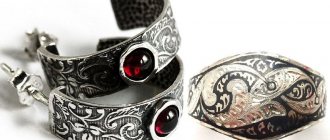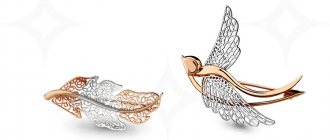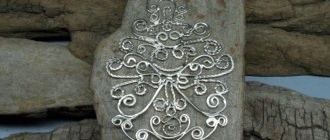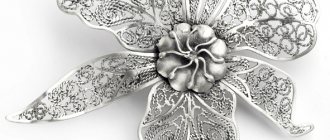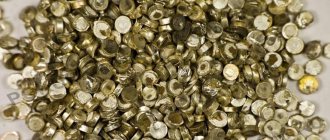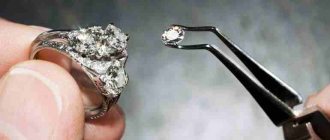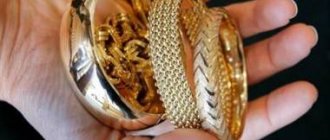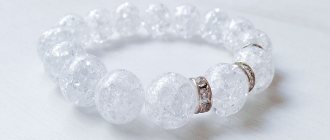Filigree, filigree, enamel.
The emergence of a fishery.
Metal art products include works of decorative and applied art intended for use in everyday life and as decoration.
The most ancient metal art objects found on the territory of the USSR date back to the 2nd–1st millennia BC. e.
Azerbaijan is one of the oldest centers of ancient metalworking culture. Archaeological finds on the territory of Azerbaijan indicate the spread of the art of metal processing here in the 3rd-2nd millennium BC. e.
By the 2nd–1st centuries. BC e. includes the jewelry art of Kazakhstan, as evidenced by metal animal figurines and other items found during excavations in the Ust-Kamenogorsk region and other places. Many gold and silver jewelry were found in Berkkarinsky. burial ground and in the Kargaly treasure.
Casting, engraving, embossing and other artistic metalworking in Armenia had already reached a high level in the 2nd millennium BC. e.
Silversmiths from the village of Kubachi (Dagestan) in the 6th century. enjoyed great fame, and the village of Gotsatl (Dagestan) was the center of copper minting 300-500 years ago. At the end of the 17th - beginning of the 18th centuries. Products with niello patterns, jewelry with inserts made of ornamental stone and colored glass by Avar craftsmen became famous. In the second half of the 19th century. In Gotsatl and nearby villages, deep, heavily minted engraving and a clear niello pattern became widespread.
In Russian decorative art, artistic metal processing has always occupied a prominent place. During the times of Kievan Rus, craftsmen mastered many methods of artistic casting, filigree-enamel techniques, gold marking, and techniques for making niello patterns.
The artistic working of metal flourished in the 14th-17th centuries. But metal processing became most widespread in Russia at the end of the 18th and beginning of the 19th centuries.
One of the types of artistic metal processing has been known since ancient times - artistic enameling.
. This art arose around the 8th-10th centuries. Chronicles and surviving products indicate the existence of enamel production in Rus' in the 12th century. The technique of colored enamels was borrowed from Byzantium, but Russian masters were able to impart national features to the art of enamel.
Over time, the enamel
modified and enriched. At first, craftsmen used cloisonné and champlevé enamels, then the technique of enamel casting, engraving and relief appeared. During the Mongol-Tatar invasion, the cloisonne enamel technique was lost. And during the XIV-XV centuries. Enamel does not play an important role in decorating objects, but is used only as a background for cast or embossed metal images.
The revival of the art of enamel dates back to the 16th century, and its heyday - to the 17th century. During this period, a variety of techniques and colors are used. In the middle of the 17th century. The enamel technique is enriched with one more technique - painting with special fire-resistant paints.
The production of products with painted enamel was organized simultaneously in Moscow and Solvychegodsk in the 40s of the 17th century, and at the beginning of the 18th century. new centers are being added to them - St. Petersburg and Rostov the Great.
Enamel was used to decorate household items (plates, dishes, knives) and church utensils. The theme of the products was church. By the beginning of the 19th century. A secular portrait appears on enamel products. Enamel production reached significant proportions in the 19th century. in Rostov the Great. In the middle and second half of the 19th century. Academicism has a noticeable influence on Rostov enamel. By the end of the 19th century. Due to the general capitalization of crafts, the crafts of enamel painting are also dying out. The restoration of the art of artistic enamel begins after the Great October Socialist Revolution.
Ancient art of niello in silver and gold
arose in the 10th century. in Chernigov and received further development in the XVI-XVII centuries. Black miniatures became widespread in the 18th century. in local art centers of the North and Siberia. The masters borrowed the technique of blackened patterns from books and engravings and introduced elements of folk art.
Chernov art became especially famous in the second half of the 18th century, when it was concentrated in Veliky Ustyug, Vologda region. At this time, it developed its own style of decorating silver items using niello. Veliky Ustyug products of the 18th century are characterized by a very dark niello engraving on a slightly recessed gold canthar background. The blacksmith art of Veliky Ustyug had a great influence on the development of silversmithing in Tobolsk. The end of the 18th and first half of the 19th centuries. characterized by a gradual reduction in the production of silver niello products.
Scan
(from Old Russian skat - to twist),
filigree
is a type of jewelry technique: an openwork or soldered pattern on a metal background made of thin gold, silver or copper wire, smooth or twisted into ropes. Filigree products are often complemented with grain (small silver or gold balls) and enamel.
Filigree is one of the traditional types of artistic metal processing. This technique, which originated in ancient times, has remained almost unchanged to this day. A flagellum twisted from two or more silver, gold or copper wires is called filigree, or filigree. The smooth wire is pulled through a series of holes in a steel plate held in a vice or on a drawing machine. The wire passed through the rollers becomes flat, in the form of a ribbon.
The preliminary drawing is made on paper, the outline of the future pattern is laid out and glued onto it. Then the parts collected in this way are sprinkled with solder (a crushed alloy of silver or gold with non-ferrous metals) and, under the influence of fire, are soldered into an openwork pattern. Depending on the design, the openwork pattern can be soldered onto metal or take on a relief shape. The filigree is supplemented with grain - small metal balls, which introduce plastic play and enrich the product. This technique gives endlessly varied variations in the combination of filigree with grain, the construction of floral and geometric patterns, and combinations with smooth metal and stones.
Story
In Kievan Rus, the filigree technique began to be used from the 9th-10th centuries. At that time, twisted wire was not yet used for production, but grains were used. Products of the 12th-13th centuries are of high quality; at that time, brazed technology began to be used more often, and from the 13th century - openwork and relief filigree; stones began to be used in production.
The 15th and 16th centuries saw the heyday of Moscow filigree. A variety of materials were used: precious stones, enamel, wood, carved bone. The most famous scanners at that time were Ambrose and Ivan Fomin.
In the 18th and 19th centuries, filigree items were produced in many art centers in Russia. Both large works of art and small items (vases, salt shakers, boxes) were created. Crystal and mother-of-pearl began to be used in production. Since the 19th century, industrial production has been established on a significant scale using various technologies. The factories produced dishes, church utensils, and toiletries.
During the years of Soviet power, filigree was widely used in the art industry (products of the Krasnoselsky jewelry factory in the Kostroma region, the Mstera art factory "Jeweler" (since 1937) in the Vladimir region, the Yerevan jewelry factory and many others). Along with jewelry, household items were made: openwork filigree vases, glass holders, miniature sculptures, etc.
Metal art is one of the most ancient crafts in Estonia. Blacksmithing, which was originally utilitarian in nature, developed into decorative and applied arts. The production of metal jewelry reached in the 17th century. Genuine flourishing. Brooches and brooches, which served as clasps for clothing, were complemented by necklaces and breast chains, and the hands were decorated with rings and bracelets.
At the end of the 18th century. In the Urals, in the Kasli region, the craft of artistic cast iron was born.
Kasli craftsmen cast creations of applied and artistic sculpture that are striking in their grace, starting with patterned candelabra, lace dishes, miniature copies of Klodt’s horses, those that adorn the Anichkov Bridge in Leningrad, and ending with jewelry crafts, which were usually made of gold, platinum, and silver. They were in great demand on the world market. In Paris, a cast iron Kaslin cigarette case had the same price as a silver one of equal mass.
At the beginning of the 19th century. In the Urals (at the former Kosotur factory), the art of decorating military weapons was born. In those days, blades were decorated not with engraving, but mainly with brush painting followed by etching of the background. Artists skillfully combined shiny and matte gold and blue with polished steel blades to create extraordinary works of art. The themes of the patterns were images of warriors, scenes of everyday life, hunting, and views of the Urals. In the second half of the last century, the production of household items began in Zlatoust: engravings depicting Ural nature, cups, writing instruments, cigarette cases, trays and various souvenirs. By the end of the 19th century. The main technique of Zlatoust products is notching with gold and silver thread on a blue background. At this time, Zlatoust metal engraving reached its peak.
From the 16th century Crafts for artistic metal processing are known in Pavlovo-on-Oka. At the beginning of the 19th century. Pavlovo becomes a major center of the metalworking industry. Artfully engraved guns, knives, pistols and other items (scissors, locks) were known not only in our country, but also abroad.
Since the 40s of the XIX century. Decorative and applied arts are experiencing a period of decline. It is characterized by a mechanical combination of shapes and ornaments.
The art of artistic metalworking reached a new peak only after the Great October Socialist Revolution. The Soviet government united artels into plants and factories, revived many artistic crafts, and gave them material support. Some processes were mechanized, and new ways of decorating products were developed based on old traditions. Enterprises began to take an active part in various exhibitions, including international ones.
Materials for production
. In the production of artistic products and souvenirs, mainly non-ferrous metals are used - copper, aluminum, zinc, tin; of noble metals - silver, less often - gold. In addition, zinc and tin are used to produce alloys and solders, and chromium and gold are used to improve the appearance of products and protect them from corrosion and abrasion. Cadmium, mercury, antimony, bismuth, arsenic, cobalt, tungsten, molybdenum, and manganese are also used. They are used mainly as small additives to alloys to change their properties or as coatings. From alloys of ferrous metals, cast iron and steel are used, from alloys of non-ferrous metals - most often cupronickel, nickel silver, tombac, semi-tompac, brass, bronze.
Copper
- reddish metal. It has high viscosity and plasticity, and therefore is used for the manufacture of products with very complex ornaments (patterns). Red copper wire in the annealed state becomes so soft and flexible that you can easily twist all kinds of cords from it and bend the most complex ornamental elements. In addition, it is very easily soldered with hard silver solder, and is well silvered and gold-plated. These properties of copper make it an indispensable material in the production of filigree products.
The coefficient of linear and volumetric expansion of copper when heated is approximately the same as that of hot enamels, and therefore, when cooled, the enamel adheres well to the copper product and does not crack or bounce off. Thanks to this, craftsmen prefer copper to all other metals for the production of enamel products.
Aluminum -
the metal is silver-white in color with a bluish tint, plate-like, easily rolled, stamped, polished, and resistant to corrosion. These properties make it possible to use aluminum for the manufacture of various types of jewelry with their subsequent anodizing and painting in gold or other colors, as well as many souvenirs - badges, key rings, models, etc.
Zinc
- bluish-gray metal with a strong metallic luster. It has high fluidity, which makes it possible to use it for the production of openwork work, as well as for solders.
Tin
- a silver-white metal, very malleable. It easily rolls out into the thinnest sheets - tin foil, and stretches well into wire. Used as solder.
Chromium
- the metal is a very beautiful silver-white color with a bluish tint. It is characterized by great hardness, resistance to moisture, alkalis, nitric acid, most gases and organic acids, as well as great resistance to mechanical wear. In the production of artistic products, chromium is used as a protective and decorative coating.
Silver
- a noble white metal. It is distinguished by its beautiful appearance, good gloss and highest reflectivity, high resistance to chemical compounds and atmospheric influences. This allows it to be used for coating (silvering) products made of base metals. Silver is easily rolled into thin sheets and drawn into thin wire, making it a good material for the production of filigree items. In its pure form, it is used for the manufacture of highly artistic enamel products, products made by chasing, engraving, or nielloed silver products. Silver is the main component in silver jewelry solders, which are used to solder silver, copper and other products.
Gold
- a noble metal of yellow color with a strong shine, soft, malleable, malleable, heavy. It has many valuable properties: it does not combine with atmospheric oxygen, does not change from the action of hydrogen sulfide, and is resistant to most acids and alkalis. Gold is soluble only in aqua regia (a mixture of nitric and hydrochloric acids in a ratio of 1:2 or 1:3), chlorine and bromine water and a solution of potassium cyanide. In production, gold is used for gilding artistic products made from base metals.
Cast iron
- an alloy of iron and carbon, black in color, with high casting properties. Used for cast and openwork work.
Steel
is
an alloy of iron and carbon (up to 2%), containing impurities of manganese, silicon, sulfur, phosphorus, and sometimes additional (alloying) elements: chromium, nickel, tungsten, etc. It is more ductile than cast iron, very hard, stable to corrosion.
Red brass
- an alloy of copper with zinc (10-12%), copper-red color, ductile, with a high melting point, easy to process in a cold state.
Polutompak
- differs from tombak in its greater content! zinc (15-20%), similar in properties to tombak, but lighter than the latter.
Brass
- an alloy of copper with zinc (32-43%), yellow. It has great plasticity and lends itself well to hot and cold pressure processing.
Cupronickel
- an alloy of copper and nickel (12-20%). It has a silvery color with a slightly yellowish tint. It differs from copper and zinc alloys in having a higher melting point. It is used to produce filigree products or for making tableware. devices coated with silver (up to 24 microns).
Nickel silver
- an alloy of copper with nickel (15%) and zinc (20%), beautiful silver color. Used in the same way as cupronickel.
Bronze
- an alloy of copper and tin (from 2 to 11%) with the addition of zinc and lead. It has a beautiful light yellow color. It has a high melting point and good casting properties. It is used in the manufacture of small sculptures and souvenir medals.
Production of products.
The production of metal art products includes the operations of forming, processing of products and surface finishing. The molding of products is carried out in different ways - casting, injection, molding, forging, bending, stamping, cutting, etc.
Casting
— forming products from molten metal. There are several methods of artistic casting: casting products into one- or two-sided earthen molds using investment molds using lost wax models; in a chill mold (metal split mold); into solid earthen forms obtained by molding and subsequent melting of wax models (used for casting unique products of complex configuration); in shell molds, when the surface of the product is pre-coated with a silicate shell, ensuring the purity of the casting (precision casting), etc. Casting is used in the manufacture of artistic products from cast iron, bronze, aluminum alloy (silumin) and zinc alloys.
Art objects are made from alloys of copper and other metals by pressure. The following types of pressure are distinguished: rolling, drawing, forging, stamping and drawing. Rolling (passing between rotating shafts) is used to produce profile products. Drawing involves pulling round rods or thick wire (wire rod) through the eyes of drawing boards. When repeatedly pulled through eyes of different diameters, a thin wire is obtained.
Forging
- plastic processing of metal by flattening with hammer blows, pressing, bending, twisting, chopping, etc. Art forging is one of the oldest methods of metal processing. There are two types of forging: hot - with pre-heating of the workpiece and cold - without heating.
bending
- a simplified type of forging. It is performed by riveting or welding bent elements of the workpiece.
Difving (punching) is an ancient method of cold processing of sheet metal no more than 2 mm thick. It is performed by striking the metal directly with a hammer, as a result of which it stretches, bends and takes on the desired shape.
By stamping sheet metal, parts of products are cut out and holes are punched.
Cutting is used in the manufacture of product parts, giving them the required shape, preparing for joining, etc. Cutting is carried out by sawing or removing chips during filing, planing, drilling, threading, etc.
Electrotype
- replication of artistic products by electrolytic means, that is, by building up metal into forms (gypsum, wax, graphite), suspended in an electrolyte solution and exposed to electric current. When processing artistic products with electroplating, pure copper, zinc, and silver are used.
Coinage
can serve as an independent way of making and decorating artistic products.
Filigree
(filigree - from the Greek word meaning to twist, twist) is one of the most interesting and ancient methods of making artistic products. The material for filigree products is twisted or smooth, sometimes flattened by rolling, wire made of copper, silver, and less often gold. Individual small details of the patterns of future products are bent from the wire. The elements of the filigree pattern are connected by soldering. The process of producing filigree art products is very labor-intensive. A pattern is drawn from the smallest pieces of twisted wire onto a metal plate with special tweezers and sprinkled with powdered alloy. Then the product is heated to the temperature necessary to bond its elements with the alloy. The filigree can be openwork or applied. Openwork filigree is an independent way to obtain various artistic objects: fruit vases, candy bowls, sugar bowls, glass holders, brooches, etc. Openwork filigree is obtained by soldering individual pattern elements, as described above. Sometimes individual details of an openwork filigree pattern are given relief by punching. Overlay filigree is a method of finishing artistic metal products.
Processing of artistic metal products includes several operations: tumbling - mechanical cleaning of the surface in rotating drums with sawdust and abrasive materials; brushing - surface treatment with rotating metal brushes to obtain a silky texture of the product (it is also used as an intermediate operation before applying electroplating); grinding with abrasive wheels and pastes or sandpaper (manually or machine); heat treatment - hardening (to increase hardness), tempering and annealing (to impart softness and ductility).
Metal art products are finished to enhance their aesthetic properties and protect them from corrosion, as well as to be more decorative (grinding followed by polishing, nitriding, anodizing, bluing, chrome plating, copper plating, silver plating, gilding, painting and varnishing).
Thorough sanding
Metal products are sanded manually or mechanically using sandpaper, abrasive paste or a wheel.
Coloring
products are made with oil or enamel paints.
Nitriding
— thermal coloring of metal in a gas environment.
Polishing
produced on rotating felt wheels using polishing pastes (crocus, chromium oxide, etc.). If necessary, individual areas of the surface are polished with a hand tool - a polishing pad. Sometimes chemical or electrochemical polishing is used in specially equipped baths. The purpose of polishing is to give metal products a mirror shine.
Anodizing
consists of electrochemical treatment of the surface of aluminum products to obtain a transparent and durable oxide film, amenable to penetrating painting and polishing. By anodizing, aluminum products can be painted gold, silver and other colors.
Blueing
- heating products in an alkaline solution or oil emulsion to form an oxide film of blue-violet, brown or reddish-brown color. In addition to protecting products from corrosion, bluing also plays a decorative role.
Chrome plating, copper plating, silver plating and gilding
— electrolytic or chemical application of anti-corrosion decorative coatings.
For decorative purposes, finishing is used: graining, matting, enamel (enamel), painting on enamel, “frost on tin,” embossing, engraving, knurling, notching, niello, etching, oxidation.
Grain
- decoration of individual elements of products with center punches (soldered metal balls with a diameter of 0.5 to 3-4 mm). Used to decorate filigree items, usually in combination with filigree.
Matting
- surface treatment of metal products with a jet of dry sand or an abrasive emulsion using sandblasting machines. It is produced to obtain a fine-grained matte texture of products.
Enameling
- decorative coating of the surface of artistic metal products with glassy mass (enamel). Enamels used in arts and crafts enterprises are divided according to composition, color, light transmission, and method of application.
By composition
There are
cold enamels
(made on the basis of urea-formaldehyde resins and applied to the product with a brush or spray, then the product is dried) and
hot
(vitreous glazes in the form of a paste, which is applied to the product with a spatula, then the product is dried and fired).
Artistic enamels come in white
and
colored
. Depending on the transparency of the enamels, they are divided into transparent (the metal base of the product is visible through the enamel), translucent or fawn (shimmering in the light), and opaque (deaf).
By application method
In enamel coating, the following types of enamels are distinguished: champlevé, cloisonné, carved enamel, relief enamel, glazed with overlays, painted.
Champlevé enamel
fills indentations made by carving, stamping, or casting metal.
Cloisonne enamel
fills the cells formed by thin metal partitions, soldered to the metal surface with an edge along the lines of the design.
Carving enamel (engraving)
is transparent, applied to the surface of the metal covered with carvings.
Enamel in relief (chased, cast)
is transparent and dull, applied to the relief of the product.
Glazed enamel with overlays
is a completely one-color enamel covering an object, onto which images and ornaments embossed from gold or silver sheet are placed before the final firing.
Painted enamel (picturesque, or enamel)
is applied to the product; The product is painted with enamel paints, fixed by firing.
Production of enamel products
includes three stages: enameling, jewelry processing and assembly.
Enamel manufacturing process
requires a lot of practical experience and professional sense of the master. The slightest mistake can irrevocably ruin an almost finished product.
First, a plate corresponding in size and shape to the future product is cut out of copper using stamping. The plate is fired (to remove grease) at a temperature of 500-600 °C. Then it is washed with liquid enamel diluted in water and dried in an oven. After this, the plate is sprinkled with enamel ground in a ball mill using a strainer. The sprinkled plates are placed on an iron plate coated with chalk and fired in a muffle furnace at 850-900 °C for 3-4 minutes. During the firing process, the enamel melts and is fixed to the copper workpiece. Due to the fact that the enamel powder covering the workpiece is very thin and uneven, the process of applying the enamel and subsequent firing is repeated several times. To ensure that the workpiece is heated more evenly and the enamel on the front side does not crack, the back side of the workpiece is covered with “counter-enamel”. This process is difficult to control and very important, since the quality of the products ultimately depends on it - strength, shine, durability of the enamel.
The next stage in obtaining enamel products is painting. The artist transfers a drawing to the workpiece (based on a previously developed sketch) and begins to paint it with porcelain paints diluted in oil. This work requires great sensitivity from him, since the color of the paint in the powdered state is significantly different from the color that is obtained after firing. The painter must know what paints need to be mixed to achieve the desired effect, what density the stroke should be. The painting is applied several times, and after each coating the workpiece is fired at a temperature of 800–900 °C. Sometimes the plates are painted and fired three, four or more times until the artist feels that he has achieved the desired color scheme. After painting, the plate is ready for assembly.
In parallel with the preparation of the plate, the frame is prepared. From rolled and twisted copper wire, the craftsman types a pattern on paper and glues it with glue, then sprinkles it with silver solder and solders it on a torch. The paper and glue fade, resulting in a black frame. It is sometimes decorated with grain, bleached, silvered, or oxidized. Next, assemblers attach the painted plate to the frame.
Enamel painting
is
the application of various images to metal plates (products) coated with single-color enamel (most often dull white). Painting is carried out with heat-resistant ceramic paints and secured by repeated firing.
"Frost on the Tin"
- identification of the crystalline structure of tin on the surface of tinned products consists of tinning, sharp cooling of the workpieces, etching the tin with a solution of hydrochloric acid, and coating the surface of the products with colored transparent varnish.
Coinage (toreutics)
— obtaining relief images on the surface of artistic metal products. It is carried out in different ways: by depositing metal on a backing matrix; applying a flat-relief pattern with special stamps; free formation of relief on a plate lining made of rubber, lead, resin. To form a relief pattern in this case, a set of various tools is used, in the form of blunt chisels, which are placed between the hammer and the product.
Engraving
- applying shallow cuts to the surface of metal products using special cutters - gravers. Engraving can be lined (the drawing is done with contour lines and strokes) and relief (when the background is sampled and the details of the image are cut into relief).
Knurling
— applying a relief pattern to concentrically shaped products. The product blank is fixed on a lathe. As it rotates, it comes into contact with a steel wheel on which the corresponding pattern is engraved.
Notch
- a method of obtaining a pattern by inlaying steel or ivory with silver, gold or copper, consists of making recesses on the surface of the product with a gravel pen and driving in metal wire or plates from the materials used for inlay.
Niel (nielo)
-
obtaining a niello graphic pattern on the surface of silver products. Niello is usually applied to silver or gold items. The technique of making niello products consists of several basic processes: engraving, applying a niello pattern, firing, grinding and polishing. First, the future pattern is engraved onto the product. The artistic value and expressiveness of the intended pattern largely depends on the skill of the engraver. After engraving, the product is thoroughly cleaned and sprinkled with an even layer of niello (an alloy consisting of tin, copper, silver, lead, and sulfur crushed into powder). Then the product is fired in a forge over low heat. During firing, the niello melts and fills in the deep engraving strokes. The cooled product is cleaned from the hardened black mass with scrapers and files. The niello remains only in the engraved places. This is followed by grinding and polishing of the product, as a result of which a black pattern appears on the surface of the silver.
Deep etching
consists in obtaining various flat-relief images by electrochemical treatment of the surface of metal products.
Oxidation (patination)
- a method of accelerated formation of a natural oxide film on the surface of products (copper, silver, brass, bronze) by treating it with a mixture of polysulfides, acids and other reagents.
See also: Enamel manufacturing technology.
Artistic enamel.
Rostov enamel.
History of Rostov enamel.
What items of silverware can be decorated with filigree?
The filigree technique can be used to create voluminous, expressive decorations on almost any item. True, to create something significant, it is necessary that the object have sufficient volume. Therefore, in relation to tableware, the space of silver wine glasses and glasses for silver is much more often used for filigree technology, rather than a silver table set. Let's not forget about convenience again. But, if we talk exclusively about technology, then there are no clearly defined restrictions.
Russian masterpieces
Filigree (along with graining) has become one of the most famous jewelry techniques in Russia. Workshops for the production of jewelry and exquisite household accessories were located at princely courts and monasteries. For many centuries, Russian jewelers have been perfecting this technology.
In the 18th-19th centuries, there were several factories producing filigree products. Real works of art made of filigree - rings, rings, brooches, pendants, amulets, rattles. Even lorgnettes and lighters were decorated using this technique, which was quite consistent with the Art Nouveau style.
In Soviet Russia, the high art of filigree was not lost. The international recognition of Russian filigree was evidenced by the gold medal it earned in France in 1937. What filigree from Russia is is well known abroad: Russian masterpieces have been repeatedly demonstrated at international exhibitions. Filigree has always been considered an excellent souvenir and gift. Openwork accessories, vases, boxes, glass holders and dishes give the interior of the house a special style.
Currently, several centers are engaged in the creation of filigree and teaching this skill. Thus, in the Nizhny Novgorod region there is the Pavlovsk College of Folk Art Crafts, and in the homeland of Kazakovsky filigree there is an enterprise of artistic products. In the Kostroma region there is the Krasnoselskoye School of Artistic Metalworking.
